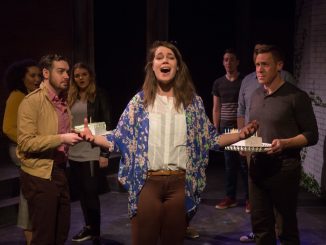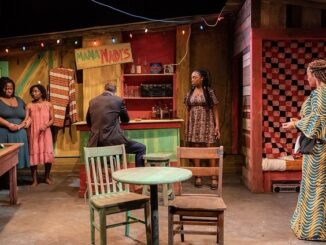
Steppenwolf Theatre Company opens with the world premiere of 1919 by Eve L. Ewing. This story was adapted by J. Nicole Brooks and directed by Gabrielle Randle-Bent and Taisia A. Jones. 1919 runs through October 29, 2022, in the Steppenwolf’s new in-the-round Ensemble Theater in honor of Helen Zell, located at 1646 N. Halsted St. in Chicago.

Before I discuss the production, I would like to familiarize readers with some of the events of 1919. The Summer of 1919 was termed “Red Summer” due to the bloodshed that spread across roughly 26 cities in the United States, sparked by white supremacist terrorism and racial riots. The Great Migration of African Americans from the South to the Northern Cities added to the growing tensions.

Racial violence increased when World War I ended, and millions of military soldiers returned home from fighting in Europe to find that black people and immigrants had filled their jobs. Because of financial worries, racial and ethnic prejudices became prevalent. African-American veterans were also agitated because they were denied adequate housing and equality after risking their lives fighting for democracy in the war, which didn’t provide them with the same advantages.

Chicago was one of the cities affected by increasing racial violence, and riots ensued because of the murder of a black teenager named Eugene Williams. On July 27, 1919, he drowned in Lake Michigan when he drifted past the segregated lines at 31st beach after being stoned by a group of white youths. His death, as well as the refusal of police to arrest the white man whom witnesses identified, incited a week of rioting between blacks and whites on the Southside of Chicago. More than one thousand Black families lost their homes in fires started by white rioters. The riots finally ended on August 3, 1919, with a death toll of thirty-eight (15 whites/23 blacks) and an additional five hundred and twenty-seven injured.

In this adaptation of 1919, Brooks attempts to cover many events during this horrendous Summer. For me, it missed the mark. Much of the story seemed lost in the overly animated and, most times, hard-to-hear dialogue. The production was busy, and the message got lost in the clutter. I had hoped for a more vivid and detailed picture of the events surrounding the storyline. Theatre is subjective, so although this was not one of my favorite productions, it does not mean others won’t find it enjoyable. Purchase tickets online or email rt*****@st*********.org.

Run Time: 90 minutes without an intermission
Photos Credits: Michael Brosilow




Be the first to comment